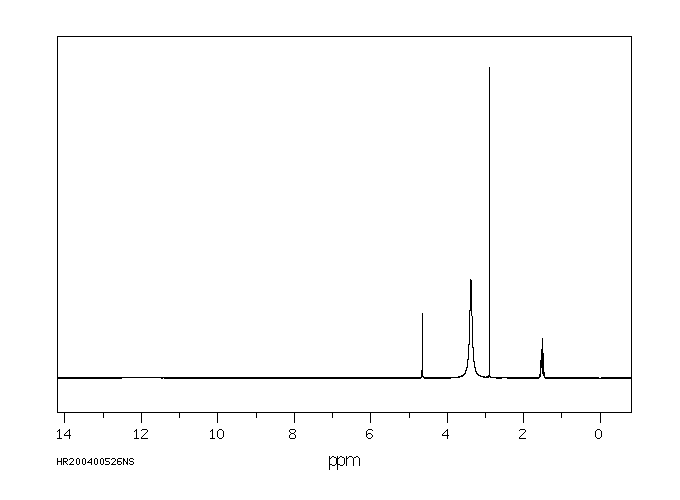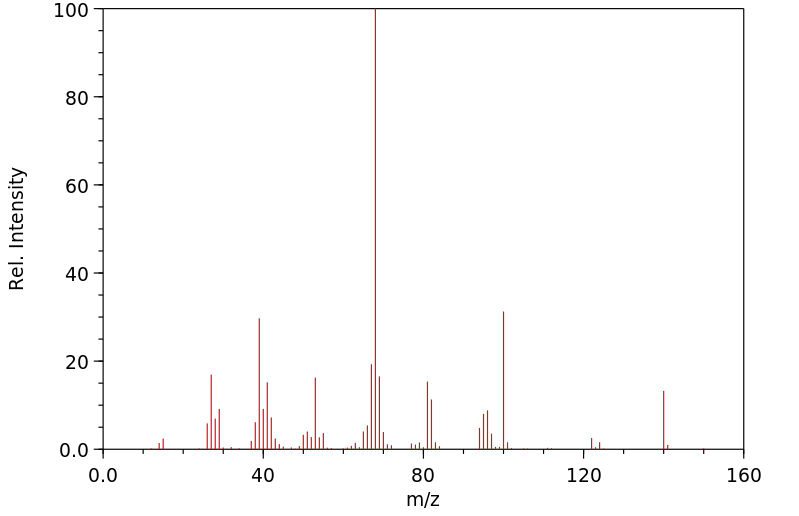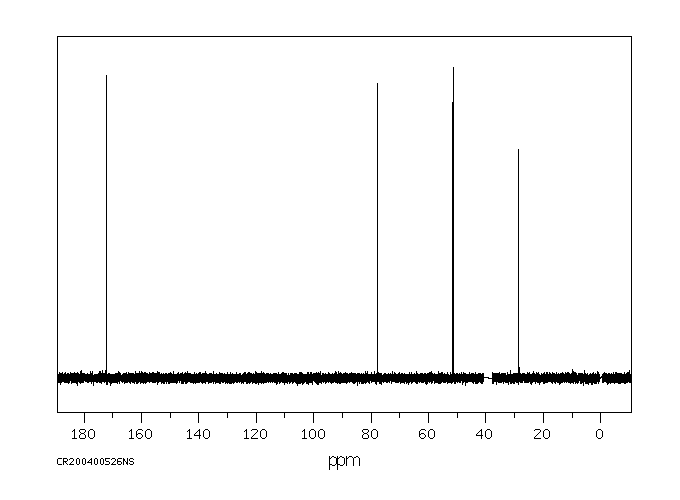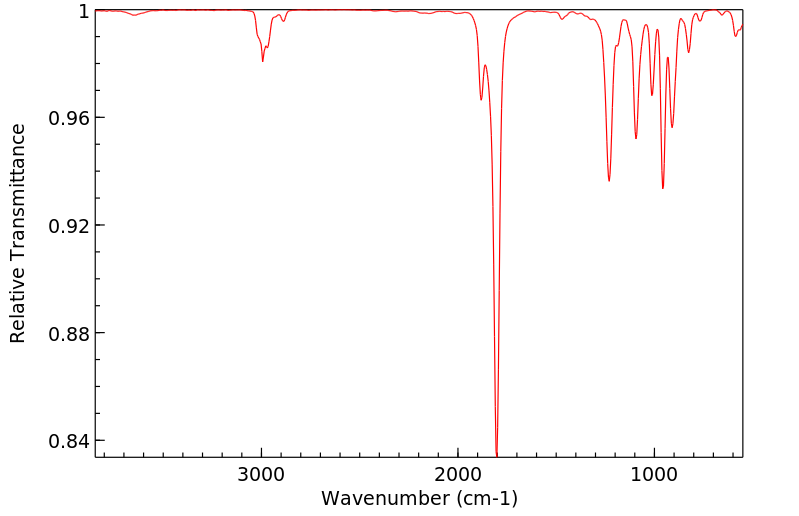茵多酸 | 145-73-3
物质功能分类
-
物化性质
-
计算性质
-
ADMET
-
安全信息
-
SDS
-
制备方法与用途
-
上下游信息
-
文献信息
-
表征谱图
-
同类化合物
-
相关功能分类
-
相关结构分类
物化性质
-
熔点:179-180℃
-
沸点:447.8±40.0 °C(Predicted)
-
密度:1.431 g/cm3
-
溶解度:DMF: 15 mg/ml,DMSO: 15 mg/ml,乙醇: 15 mg/ml,PBS (pH 7.2): 0.2 mg/ml
-
物理描述:The monohydrate is in the form of colorless crystals. Non corrosive. Used as a selective herbicide.
-
颜色/状态:Cyrstalline, white solid
-
气味:Odorless
-
蒸汽压力:1.57X10-10 mm Hg at 24 °C
-
稳定性/保质期:
剧毒!半数致死量(大鼠,经口)为38 mg/kg。它对皮肤有刺激性,并可能导致摄入后腹泻和呕吐。
-
分解:When heated to decomposition it emits acrid smoke and fumes.
-
腐蚀性:Non-corrosive to metals
-
解离常数:pKa1 = 3.40; pKa2 = 6.7
-
保留指数:1479.1
计算性质
-
辛醇/水分配系数(LogP):-0.5
-
重原子数:13
-
可旋转键数:2
-
环数:2.0
-
sp3杂化的碳原子比例:0.75
-
拓扑面积:83.8
-
氢给体数:2
-
氢受体数:5
ADMET
安全信息
-
危险等级:6.1(a)
-
危险类别码:R36/37/38,R25,R21
-
海关编码:2932190013
-
包装等级:II
-
危险类别:6.1(a)
-
危险品运输编号:UN 2811 6.1/PG 2
SDS
| 第一部分:化学品名称 |
| 化学品中文名称: | 草多索;3,6-桥氧六氢苯二甲酸二钠 |
| 化学品英文名称: | Endothal;Disodium 3,6-endoxohexahydrophthalate |
| 中文俗名或商品名: | |
| Synonyms: | |
| CAS No.: | 145-73-3 |
| 分子式: | C 8 H 8 O 5 Na 2 |
| 分子量: | 230.1 |
| 第二部分:成分/组成信息 |
| 纯化学品 混合物 | ||||||
| 化学品名称:草多索;3,6-桥氧六氢苯二甲酸二钠 | ||||||
|
| 第三部分:危险性概述 |
| 危险性类别: | 第6.1类毒害品 |
| 侵入途径: | 吸入 食入 经皮吸收 |
| 健康危害: | 本品为中等毒除草剂。对眼睛、粘膜和皮肤有刺激作用。 |
| 环境危害: | |
| 燃爆危险: | 本品不燃,有毒,具刺激性。 |
| 第四部分:急救措施 |
| 皮肤接触: | 用肥皂水及清水彻底冲洗。就医。 |
| 眼睛接触: | 拉开眼睑,用流动清水冲洗15分钟。就医。 |
| 吸入: | 迅速脱离现场至空气新鲜处。保持呼吸道通畅。如呼吸困难,给输氧。如呼吸停止,立即进行人工呼吸。就医。 |
| 食入: | 饮足量温水,催吐。洗胃,导泄。就医。 |
| 第五部分:消防措施 |
| 危险特性: | 不易燃烧。受高热分解,放出有毒的烟气。 |
| 有害燃烧产物: | 一氧化碳、二氧化碳、氧化钠。 |
| 灭火方法及灭火剂: | 根据着火原因选择适当灭火剂灭火。 |
| 消防员的个体防护: | 消防人员必须穿全身防火防毒服,在上风向灭火。 |
| 禁止使用的灭火剂: | |
| 闪点(℃): | |
| 自燃温度(℃): | |
| 爆炸下限[%(V/V)]: | |
| 爆炸上限[%(V/V)]: | |
| 最小点火能(mJ): | |
| 爆燃点: | |
| 爆速: | |
| 最大燃爆压力(MPa): | |
| 建规火险分级: |
| 第六部分:泄漏应急处理 |
| 应急处理: | 隔离泄漏污染区,周围设警告标志,建议应急处理人员戴自给式呼吸器,穿化学防护服。不要直接接触泄漏物,小心扫起,避免扬尘—,装入备用袋中。用水刷洗泄漏污染区,经稀释的污水放入废水系统。如大量泄漏,收集回收或无害处理后废弃。 |
| 第七部分:操作处置与储存 |
| 操作注意事项: | 密闭操作,局部排风。防止粉尘释放到车间空气中。操作人员必须经过专门培训,严格遵守操作规程。建议操作人员佩戴自吸过滤式防尘口罩,戴化学安全防护眼镜,穿防毒物渗透工作服,戴橡胶手套。避免产生粉尘。避免与氧化剂接触。配备泄漏应急处理设备。倒空的容器可能残留有害物。 |
| 储存注意事项: | 储存于阴凉、通风的库房。远离火种、热源。防止阳光直射。包装密封。应与氧化剂、食用化学品分开存放,切忌混储。配备相应品种和数量的消防器材。储区应备有合适的材料收容泄漏物。 |
| 第八部分:接触控制/个体防护 |
| 最高容许浓度: | 中 国 MAC:未制订标准前苏联 MAC:未制订标准美国TLV—TWA:未制订标准 |
| 监测方法: | |
| 工程控制: | 密闭操作,局部排风。 |
| 呼吸系统防护: | 空气中粉尘浓度超标时,必须佩戴自吸过滤式防尘口罩。紧急事态抢救或撤离时,应该佩戴空气呼吸器。 |
| 眼睛防护: | 戴化学安全防护眼镜。 |
| 身体防护: | 穿防毒物渗透工作服。 |
| 手防护: | 戴橡胶手套。 |
| 其他防护: | 工作现场禁止吸烟、进食和饮水。工作后,淋浴更衣。注意个人清洁卫生。 |
| 第九部分:理化特性 |
| 外观与性状: | 无色固体。 |
| pH: | |
| 熔点(℃): | 144 |
| 沸点(℃): | |
| 相对密度(水=1): | |
| 相对蒸气密度(空气=1): | |
| 饱和蒸气压(kPa): | |
| 燃烧热(kJ/mol): | |
| 临界温度(℃): | |
| 临界压力(MPa): | |
| 辛醇/水分配系数的对数值: | |
| 闪点(℃): | |
| 引燃温度(℃): | |
| 爆炸上限%(V/V): | |
| 爆炸下限%(V/V): | |
| 分子式: | C 8 H 8 O 5 Na 2 |
| 分子量: | 230.1 |
| 蒸发速率: | |
| 粘性: | |
| 溶解性: | 溶于水、甲醇、丙酮、苯。 |
| 主要用途: | 用作农用除草剂、脱叶剂、农药标准。 |
| 第十部分:稳定性和反应活性 |
| 稳定性: | 在常温常压下 稳定 |
| 禁配物: | 强氧化剂。 |
| 避免接触的条件: | |
| 聚合危害: | 不能出现 |
| 分解产物: | 一氧化碳、二氧化碳、氧化钠。 |
| 第十一部分:毒理学资料 |
| 急性毒性: | LD50:182—197mg/kg(大鼠经口) LC50: |
| 急性中毒: | |
| 慢性中毒: | |
| 亚急性和慢性毒性: | |
| 刺激性: | |
| 致敏性: | |
| 致突变性: | |
| 致畸性: | |
| 致癌性: |
| 第十二部分:生态学资料 |
| 生态毒理毒性: | |
| 生物降解性: | |
| 非生物降解性: | |
| 生物富集或生物积累性: |
| 第十三部分:废弃处置 |
| 废弃物性质: | |
| 废弃处置方法: | 建议用焚烧法处置。在能利用的地方重复使用容器或在规定场所掩埋。 |
| 废弃注意事项: |
| 第十四部分:运输信息 |
| |
| 危险货物编号: | 61904 |
| UN编号: | 2588 |
| 包装标志: | |
| 包装类别: | |
| 包装方法: | 塑料袋或二层牛皮纸袋外全开口或中开口钢桶;两层塑料袋或一层塑料袋外麻袋、塑料编织袋、乳胶布袋;塑料袋外复合塑料编织袋(聚丙烯三合一袋、聚乙烯三合一袋、聚丙烯二合一袋、聚乙烯二合一袋);塑料袋或二层牛皮纸袋外普通木箱;螺纹口玻璃瓶、塑料瓶、复合塑料瓶或铝瓶外普通木箱;塑料瓶、两层塑料袋或两层牛皮纸袋(内或外套以塑料袋)外瓦楞纸箱。 |
| 运输注意事项: | 铁路运输时包装所用的麻袋、塑料编织袋、复合塑料编织袋的强度应符合国家标准要求。运输前应先检查包装容器是否完整、密封,运输过程中要确保容器不泄漏、不倒塌、不坠落、不损坏。严禁与酸类、氧化剂、食品及食品添加剂混运。运输时运输车辆应配备泄漏应急处理设备。运输途中应防曝晒、雨淋,防高温。公路运输时要按规定路线行驶,勿在居民区和人口稠密区停留。 |
| RETCS号: | |
| IMDG规则页码: |
| 第十五部分:法规信息 |
| 国内化学品安全管理法规: | 化学危险物品安全管理条例 (1987年2月17日国务院发布),化学危险物品安全管理条例实施细则 (化劳发[1992] 677号),工作场所安全使用化学品规定 ([1996]劳部发423号)等法规,针对化学危险品的安全使用、生产、储存、运输、装卸等方面均作了相应规定;常用危险化学品的分类及标志 (GB 13690-92)将该物质划为第6.1 类毒害品。 |
| 国际化学品安全管理法规: |
| 第十六部分:其他信息 |
| 参考文献: | 1.周国泰,化学危险品安全技术全书,化学工业出版社,1997 2.国家环保局有毒化学品管理办公室、北京化工研究院合编,化学品毒性法规环境数据手册,中国环境科学出版社.1992 3.Canadian Centre for Occupational Health and Safety,CHEMINFO Database.1998 4.Canadian Centre for Occupational Health and Safety, RTECS Database, 1989 |
| 填表时间: | 年月日 |
| 填表部门: | |
| 数据审核单位: | |
| 修改说明: | |
| 其他信息: | 5 |
| MSDS修改日期: | 年月日 |
制备方法与用途
草多索存在4个异构体,其中rel-(1R,2S,3R,4S)-异构体的除草活性最佳。它是一种无色结晶(含一个结晶水),熔点为144℃(含一个结晶水)。蒸气压在24.3℃时为2.09×10^7 mPa。相对密度为1.431(20℃)。其溶解度如下:水中可溶于100 g,甲醇中可溶于280 g,二氧六环中可溶于76 g,丙酮中可溶于70 g,异丙醇中可溶于17 g,乙醚中仅能溶解1 g,苯中几乎不溶。草多索对光稳定,在90℃下保持稳定,但超过90℃时会缓慢转化为酐。该物质为二元酸,可以形成水溶性的胺和碱金属盐,其pKa值分别为3.4和6.7。它不易燃。茵多酸二钾盐在水中溶解度大于等于6.5 g/100 mL;而茵多酸-单盐(N,N-二甲基烷基铵)中烷基为C8~C18时,在水中的溶解度可达50 g/100 mL。
毒性大鼠经口急性毒性LD₅₀值范围为38~45 mg/kg(纯品),206 mg/kg(66.7%铵盐)。兔经皮急性毒性大于2000 mg/L。吸入LC(14d)为0.68 mg/L。在饲料中,大鼠的非致毒剂量NOEL值为每公斤饲料1000 mg。EPA推荐每日可接受摄入量ADI为0.007 mg/kg。
大鼠经口急性毒性LD₅₀值为98 mg/kg。兔经皮急性毒性大于2000 mg/L。对兔子眼睛有严重刺激性,皮肤轻微刺激性;但对豚鼠皮肤无致敏作用。
茵多酸二钠盐
大鼠经口急性毒性LD₅₀值在182~197 mg/kg(19.2%水溶液)。皮肤和眼睛均有刺激性。N,N-二甲基烷基铵的单盐,在大鼠经口毒性试验中,其LD₅₀值为233.4 mg/kg;经皮急性毒性LD₅₀值为480.9 mg/kg。对兔子的眼睛和皮肤有严重刺激作用,而豚鼠的皮肤无致敏性。此外,它的大鼠吸入LC₅₀(4小时)为0.7 mg/L。
环境行为(1) 动物体内可快速吸收,消除半衰期DT₅₀约为1.8~2.5小时。 (2) 植物体内的残留主要由该物质本身构成。 (3) 在有氧土壤中,其在土壤中的降解半衰期DT₅₀为8.5天。K值范围为1.3~37.1。
应用草多索主要用于蔬菜田(如菠菜、甜菜)、草坪的苗前或苗后除草,推荐使用剂量为2.0~6.0 kg/a.i./hm²。它也可作为首蓿、马铃薯干燥剂和棉花脱叶剂,并用于防除藻类及水生杂草。
上下游信息
-
下游产品
中文名称 英文名称 CAS号 化学式 分子量 7-氧杂双环[2.2.1]庚烷-2,3-二甲酸单 2-甲酯 norcantharidin monomethyl ester 57105-58-5 C9H12O5 200.191
反应信息
-
作为反应物:描述:茵多酸 在 sodium tetrahydroborate 、 氨 、 sodium ethanolate 、 dimethyl azodicarboxylate 、 三苯基膦 作用下, 以 四氢呋喃 、 乙醇 为溶剂, 反应 77.0h, 生成参考文献:名称:受阻α-酰基亚胺离子的烯烃环化摘要:立体控制的NaBH 4 / H⊕-还原3,4-顺式-双取代的N-烯基酰亚胺1-5导致仲羟基内酰胺。叔羟基内酰胺是通过将MeMgCl加到酰亚胺2和4中形成的。羟基内酰胺的HCOOH环化通过立体选择性α-酰基亚胺闭环提供多环哌啶。伴随的同步和逐步环化途径在叔α-酰基亚胺离子反平面添加到Me取代的烯烃8c和11c中起作用。DOI:10.1016/0040-4020(82)85067-9
-
作为产物:参考文献:名称:Design, synthesis and biological evaluation of demethylcantharidate-linked platinum(II) complexes of N-monoalkyl-1R,2R-diaminocyclohexane derivatives摘要:Nine platinum(II) complexes with N-monoalkyl 1R, 2R-DACH derivatives as carrier ligands and demethyl-cantharidate as a leaving group were synthesized and spectrally characterized. All the complexes showed considerable cytotoxicity against tested human cancer cell lines: A549, HCT116 HepG-2 and MCF7 cell lines. Especially, complex 2 exhibited potent cytotoxicity against A549 (1.01 mu M) and HCT116 (0.83 mu M) cell lines, and showed no cross-resistance to cisplatin against SGC7901/CDDP cell line (RF = 1.44). In addition, the typical compounds were further studied by flow cytometric analysis and western blot method. The results indicated that they induced apoptosis by a mitochondrial-dependent pathway, which were similar to cisplatin. (C) 2017 Elsevier B.V. All rights reserved.DOI:10.1016/j.ica.2017.03.033
文献信息
-
[EN] ACC INHIBITORS AND USES THEREOF<br/>[FR] INHIBITEURS DE L'ACC ET UTILISATIONS ASSOCIÉES
-
[EN] 3-[(HYDRAZONO)METHYL]-N-(TETRAZOL-5-YL)-BENZAMIDE AND 3-[(HYDRAZONO)METHYL]-N-(1,3,4-OXADIAZOL-2-YL)-BENZAMIDE DERIVATIVES AS HERBICIDES<br/>[FR] DÉRIVÉS DE 3-[(HYDRAZONO))MÉTHYL]-N-(TÉTRAZOL-5-YL)-BENZAMIDE ET DE 3-[(HYDRAZONO)MÉTHYL]-N-(1,3,4-OXADIAZOL-2-YL)-BENZAMIDE UTILISÉS EN TANT QU'HERBICIDES申请人:SYNGENTA CROP PROTECTION AG公开号:WO2021013969A1公开(公告)日:2021-01-28The present invention related to compounds of Formula (I): or an agronomically acceptable salt thereof, wherein Q, R2, R3, R4, R5 and R6 are as described herein. The invention further relates to compositions comprising said compounds, to methods of controlling weeds using said compositions, and to the use of compounds of Formula (I) as a herbicide.本发明涉及以下式(I)的化合物或其农业上可接受的盐,其中Q、R2、R3、R4、R5和R6如本文所述。该发明还涉及包含所述化合物的组合物,使用这些组合物控制杂草的方法,以及将式(I)的化合物用作除草剂的用途。
-
[EN] MICROBIOCIDAL OXADIAZOLE DERIVATIVES<br/>[FR] DÉRIVÉS D'OXADIAZOLE MICROBIOCIDES申请人:SYNGENTA PARTICIPATIONS AG公开号:WO2017157962A1公开(公告)日:2017-09-21Compounds of the formula (I) wherein the substituents are as defined in claim 1, useful as a pesticides, especially fungicides.式(I)的化合物,其中取代基如权利要求1所定义,作为杀虫剂特别是杀菌剂有用。
-
[EN] INSECTICIDAL TRIAZINONE DERIVATIVES<br/>[FR] DÉRIVÉS DE TRIAZINONE INSECTICIDES申请人:SYNGENTA PARTICIPATIONS AG公开号:WO2013079350A1公开(公告)日:2013-06-06Compounds of the formula (I) or (I'), wherein the substituents are as defined in claim 1, are useful as pesticides.式(I)或(I')的化合物,其中取代基如权利要求1所定义的那样,可用作杀虫剂。
-
[EN] HERBICIDALLY ACTIVE HETEROARYL-S?BSTIT?TED CYCLIC DIONES OR DERIVATIVES THEREOF<br/>[FR] DIONES CYCLIQUES SUBSTITUÉES PAR HÉTÉROARYLE À ACTIVITÉ HERBICIDE OU DÉRIVÉS DE CELLES-CI申请人:SYNGENTA LTD公开号:WO2011012862A1公开(公告)日:2011-02-03The invention relates to a compound of formula (I), which is suitable for use as a herbicide wherein G is hydrogen or an agriculturally acceptable metal, sulfonium, ammonium or latentiating group; Q is a unsubstituted or substituted C3-C8 saturated or mono-unsaturated heterocyclyl containing at least one heteroatom selected from O, N and S, or Q is heteroaryl or substituted heteroaryl; m is 1, 2 or 3; and Het is an optionally substituted monocyclic or bicyclic heteroaromatic ring; and wherein the compound is optionally an agronomically acceptable salt thereof.
表征谱图
-
氢谱1HNMR
-
质谱MS
-
碳谱13CNMR
-
红外IR
-
拉曼Raman
-
峰位数据
-
峰位匹配
-
表征信息










